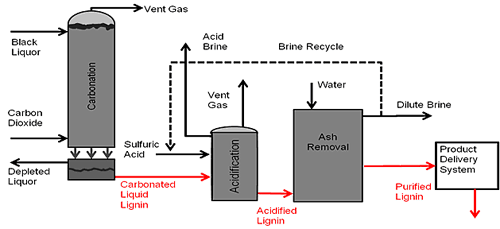 |
||||||||
| February 22, 2012 | ||||||||
| Tissue Issue #2 - Rebuilding the headbox |  |
|||||||
| · www.tappi.org · Subscribe to Ahead of the Curve · Newsletters · Ahead of the Curve archived issues · Contact the Editor |
New way to produce lignin from black liquor Sequential Liquid-Lignin
Recovery & Purification (SLRP) is a new, continuous process for producing
lignin from black liquor and is being developed by Charleston, S.C.-based
Liquid Lignin Company, LLC (LLCē). A patent by Michael Lake and John Blackburn
is pending.
SLRP's development has been funded by Small Business Innovation Research
(SBIR) grants from the Department of Energy. LLCē won their Phase I
in November 2009 and their Phase II in August 2010; their total DOE
award is $1.15M.
LLCē is currently starting up a pilot plant. They further plan to construct
a prototype SLRP process within a southeastern papermaking operation
in early 2013, capable of producing 3-6 tons/day of product lignin.
The basic principle underlying SLRP technology is recovering a dense-phase
"liquid lignin" from a black liquor stream by reducing the pH with carbon
dioxide (CO2) and maintaining elevated temperature and pressure
to keep the mixture from boiling. This allows retaining the heat of
reaction (CO2with black liquor components) in the system.
The depleted black liquor stream is returned to the evaporator system
at a higher temperature than the black liquor sent to the SLRP. This
step alone saves significant energy compared to competitive lignin recovery
processes which lower the black liquor temperature to precipitate filterable
lignin. Alternative processes lose not only the heat of reaction of
CO2but also the sensible heat from cooling the black liquor
feed.
SLRP's Unit Operations Competitive processes--all of which operate at much lower temperature
than SLRP--are likely to be much more temperature sensitive. The temperature
of those processes must be maintained sufficiently high so that the
skin of each lignin particle is soft enough to stick when they collide,
forming agglomerates of small particles which can be filtered more easily.
But the temperature cannot be so high that the particles melt and fuse,
since an unfilterable mud would result. The temperature has to be maintained
in a relatively narrow operating range. This optimum temperature window
can change if the properties of the incoming black liquor change. SLRP
has been found to be insensitive to temperature changes, and multiple
black liquor feedstocks have behaved similarly under the same temperature
operating conditions.
SLRP is totally continuous. The liquid-lignin phase from the carbonation
stage is pumped into an acidification reactor where the lignin is reduced
to pH 2-3 to shift the equilibria of sodium and other cations on the
lignin to favor their partitioning in the aqueous phase. The acidification
reactor is operated under pressure and temperature maintained at an
elevated level, so the acid brine can be concentrated. Again the heat
of reaction--a substantial heat from reaction of sulfuric acid--is retained
by the SLRP system and returned to the host mill's evaporator system
contained within the acid brine.
From the acidification reactor, the lignin is pumped to an ash removal
system where residual acid and sulfate brine are displaced from the
lignin phase by countercurrent contact with water. Like the previous
carbonation and acidification systems, the ash removal system is operated
under pressure and at elevated temperature. Since it is continuously
generated, the dilute brine from this system can be recycled and used
as diluent for the concentrated sulfuric acid stream entering the acidification
reactor, significantly reducing the water requirements of the overall
system. The competitive batch lignin recovery systems can do this also,
but large storage tanks would be required and the temperatures would
be much lower, near ambient for the brine recycle stream.
SLRP can be designed with very small tanks, essentially surge vessels
in the interconnecting process lines that interface with the host mill.
Because of its continuous nature, SLRP can be operated with relatively
few operators.
SLRP can recover more than 50% of the lignin from the total black liquor,
allowing a proportional increase of black liquor flow through a Recovery
Furnace. Implementing any lignin recovery technology would give papermakers
two strong benefits:
Lignin's use as a value-added "green chemistry" alternative to petrochemicals
was extremely limited when the price of imported oil was less than $20/bbl
in years preceding 2000. But today, with imported oil approaching $100/bbl,
numerous opportunities exist.
LLCē will participate in the "Future Products for the Pulp and
Paper Industry" panel at PaperCon 2012 in New Orleans, which will
be held at 1:30 PM, Monday April 23, 2012. Michael Lake will describe
the science underlying the SLRP process and the future potential applications
for lignin. Contact him at: michael@liquidlignin.com.
Now that you
are Ahead of the Curve, stay there by joining TAPPI. |
|||||||
 |
||||||||




